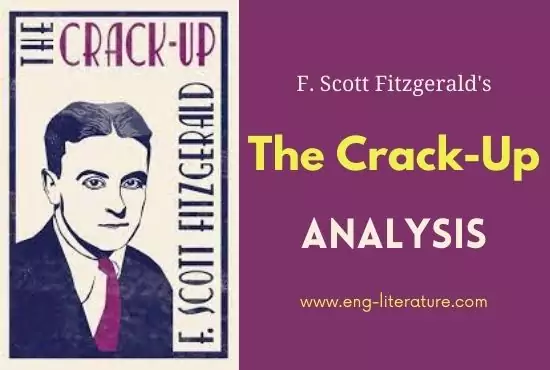The Crack-Up by F. Scott Fitzgerald Analysis
F. Scott Fitzgerald borrows the title of his book, “The Crack-Up” from three autobiographical essays, “The Crack-Up,” “Pasting it Together,” and “Handle with Care,” that were published in Esquire magazine in February, March, and April of 1936, respectively. The Crack-Up is Fitzgerald’s personal account and experience with depression and alcoholism, and indirectly with his wife’s disorder Zelda.
The essay “The Crack-Up” is an elaborate description and analysis of the mental breakdown the author experienced and the depths of its causes. After a life of struggling to succeed and failing multiple times, he suddenly reconsiders why he needs to succeed at all and whether it is what he really wants. Fitzgerald’s breaking down was a process of losing all of his values by realizing that things, people and all aspects of life that he once adored were adopted from others.
In his newfound perspective, these things held no true value for him. Finally, he no longer loved anything so he had no obligation to pretend he did, translating into a cold-hearted man who was not to do anything if not for himself. Fitzgerald, after a few pages of mystery, describes the cause of his mental illness as a lack of self, in which he has no original concepts of success. He’d been bound to social expectations such as “how to do, what to say” which didn’t directly profit him yet he struggled so tirelessly to achieve.
He underwent these struggles and social norms to achieve “another man(‘s)… sense of the ‘good life”. These superficial goals were impossible for him to accomplish, though he was determined to do so, therefore they broke him down. He was left without notions he could believe he’d created himself. The only thing he had left to hold onto of himself was his hard-working persona, though it had been in many ways utilized in a non-self-profiting manner. After a long period of isolation in which he was disgusted with his old values, he decided to separate himself from them completely. He would engineer a “clean break”, abandoning all efforts that did not benefit him directly. He continued his life working hard toward what would profit only him.
Though Fitzgerald abandoned the necessities he had for superficial success, he adopted an entirely selfish lifestyle that might have led to further unhappiness, Fitzgerald’s self-evolution exhibited a rare process in people in which he was able to detach himself from the unimportant and achievable by redefining his values.
Fitzgerald compares himself to a cracked plate, explaining, the cracked plate has to be retained in the pantry… It can never again be warmed on the stove nor shuffled with the other plates in the dishpan..” In this example, Fitzgerald claims that the cracked plate has to be isolated, affecting its character. Similar to the plate, he also is damaged, changing his nature. This powerful analogy illustrates Fitzgerald’s newfound isolation, and how he is changed, like the plate. He also gives the piece a dramatic undertone. While asking advice from a doctor, he describes, “I might have asked some of it from her, neatly wrapped and ready for home cooking and digestion, but I could never have got it – not if I’d waited around for a thousand hours with the tin cup of self – pity”.
In this example, Fitzgerald emphasizes his emotions and by using these strategies, achieved his purpose. In “The Crack-Up”, F. Scott Fitzgerald exposes his vulnerable and wavering character yet manages to find solace by pulling into himself and his writing.

Hello, Viewers! Besides being the Founder and Owner of this website, I am a Government Officer. As a hardcore literary lover, I am pursuing my dream by writing notes and articles related to Literature. Drop me a line anytime, whether it’s about any queries or demands or just to share your well-being. I’d love to hear from you. Thanks for stopping by!

How is the title crack up appropriate
Yes… stay tune